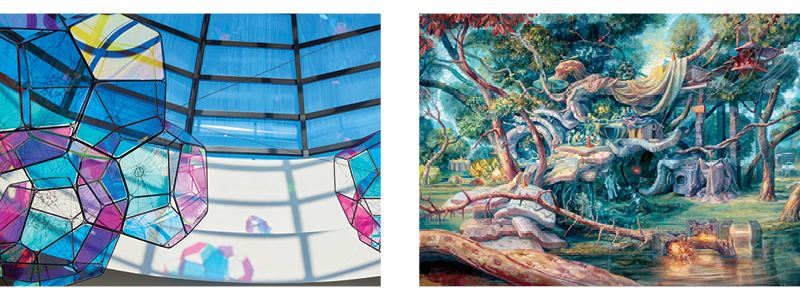
My girlfriend — OK, she’s not really my girlfriend. She’s my consort. That’s the term we chose for each other as being suitably upscale, vaguely romantic, and — let’s face it —more age-appropriate.
Anyway, my consort is fluent about the visual arts. When we’re at galleries and exhibits, she speaks eloquently of brushstrokes and color schemes. I respond with submissive posturing and soft-pallet vocalizations akin to footage you might encounter in a Jane Goodall documentary.
I like art. I just don’t know how to talk about it. If I sit down at my desk and mull for a bit, I can come up with something. Otherwise all I’ve got is a drop-down menu with a choice of three boxes: nice, meh and um.
I’m in my element, on the other hand, when I encounter an interesting backstory, such as the inspiration for the artwork or the evolution of the artist.
Take the recent installation of web-like tendrils encased in translucent, multicolored forms, which hovers overhead in the glass-domed atrium of Winter Park’s Alfond Inn, owned by Rollins College. It’s called Cloud Cities – Nebulous Thresholds.
Nice.
Better still, the piece has a tale to tell.
Its Argentinian-born, German-based creator, Tomás Saraceno, is a blue-sky thinker, literally and figuratively. He’s obsessed with spider webs, astrophysics and ecology — suggesting a link among them in his art.
Elsewhere, he has devised filmy, gravity-defying sculptures, suspended by infrared radiation and the heat of the sun — creations that bespeak his dream that someday, people will live harmoniously in international communities floating high above the earth.
It’s a testament to the turmoil of our times that much of contemporary art is preoccupied, as Saraceno’s is, with social, environmental and humanitarian causes.
That trend is reflected, for example, by the artist whose work graces the cover of this magazine. Likewise, it’s reflected throughout the Alfond’s hotel-wide collection, which is culled from the college’s Cornell Fine Arts Museum and its Alfond Collection of Contemporary Art.
You’ll see that same socially conscious sensibility in exhibits that have sprung up with increasing regularity at most Central Florida art museums and galleries over the past several years.
Julie Heffernan’s cautionary dreamscapes, on display at the Mennello Museum of American Art through June 10, are among the most arresting.
Heffernan, who grew up in California and now lives in New York City, visually imagines a future in which people struggle to escape a detritus-strewn flood by inhabiting luminously rendered trees — the final refuge of a natural world too long abused.
In some ways, Heffernan is a throwback: Her cautionary and overtly symbolic tableaus are often compared to the creations of Hieronymous Bosch, the 16th century fire-and-brimstone Dutch moralist whose paintings spill over with half-naked figures in the midst of either having way too much fun or being posthumously punished for it.
Heffernan calls her works “self-portraits,” painting herself into the middle of the post-apocalyptic scrum, crediting “all of the stuff that hit my eyeballs” over the course of her life as inspiration.
That includes the vividly painted holy cards of martyred saints she remembers from her Catholic grade school days — she remembers staring at them and imagining them coming to life — as well as a spooky, rambling, unfinished Victorian mansion that left indelible ripples on her imagination.
As a kid growing up in Marin County, Heffernan’s parents would take her and her siblings to a tourist attraction called Winchester Mystery House in San Jose.
“It was built by the widow of the man who invented the Winchester rifle,” she told me. “When he died, a medium advised her to build a home and never stop building it — otherwise the ghosts of all the people who were killed by her husband’s invention would haunt her. So she did. She never finished. There are stairways and passages that lead to nowhere.”
Many years later, while studying art on a Fulbright scholarship, Heffernan found herself in a haunted maze of another sort: Berlin in the 1980s.
The wall between the east and west sectors still stood. Spies and former Nazis were everywhere. When the landlord of the cold-water hinterhof flat she shared with her boyfriend found out he was Jewish, he came close to evicting them.
“West Berlin was an amazing place then,” she said. “It wore its subconscious on its sleeve. There were bomb craters and shrapnel everywhere, and memorial cobblestones in front of the houses of Jews who had been taken away to the concentration camps.”
It was in Berlin where Heffernan developed the labyrinthian oeuvre that she now uses to address climate change. Like Saraceno’s, her creations suggest we can rise above it all — both artists having invented visual cues that can be deciphered and understood, assuming we take the time.
You can see what I mean about backstories.
Michael McLeod is a contributing writer for Winter Park Magazine and an adjunct instructor in the English department at Rollins College.
